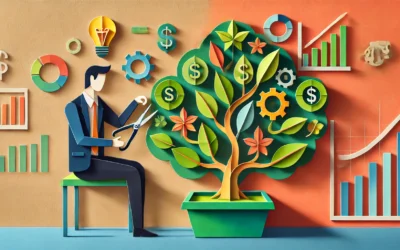It’s hard for me to believe I’ve been at this—being a design professional—for nearly 25 years. I grew up around relatives who worked on Wall Street, in the legal profession, sales or other business pursuits. So I’m fortunate that my parents encouraged my talent and pursuit of a creative profession, despite pondering if I could make a living at it since they didn’t know any creative arts professionals who could guide me. The only advice for choosing a career that my father gave me was these three words: “Do what you love, and the money will follow.”
So I had to discover for myself the career potential of, and how to go about landing, a job in graphic design. Early on I was introduced to the trade publications of our profession such as Communication Arts, Graphis, Dynamic Graphics, GDUSA, PRINT and HOW. I joined AIGA and the Art Directors Club as a student and started going to events and networking during my first year of college because that’s just what we did in the pre-internet era.
I started working professionally as a freelancer before I graduated from the School of Visual Arts; I later gained experience working in-house. My career so far has included being a front-line designer, creative director, and in-house creative services leader in a variety of industries, and I have also been self-employed (twice) serving my own clients.
Since 2001, I have been teaching design, marketing and branding to undergraduate and graduate students and have served on the board of directors of InSource—a professional association of in-house creative leaders—since 2007, leading the organization as President since 2010. So you could say I have had a diverse career practicing and serving within the design field.
In my roles as an educator, corporate in-house leader, and leader of InSource, I am most often asked by designers who are just starting out on their own career journey: “Which is better, an in-house or agency job?” My answer is always the same: “It depends. It depends on what kind of work you want to do, what stage of your career you are in, what stage of your life you are in and what you want to do with your career.”
When faced with the “thanks for not answering my question” eye roll, I then—as most teachers do—begin to make my point by telling my own abbreviated story about my career journey.
These two short articles are my written version of what I tell my students and young designers to help them better understand some of the differences between working at an agency or in-house as a freelancer or an employee, leading a creative team or working for yourself.
Some advice I once received on choosing among career paths
I’m going to start this off with some sage advice I received about 10 years ago when I was somewhere at the midpoint of my career. This advice came from a colleague of mine at KPMG—one of the “big four” audit, tax and advisory services firms—when I was leading the creative team that I had started there. She worked in a different department but had become a mentor to me while working at the firm. She told me about a time when her own mentor relayed the following advice: “There are three reasons people choose to work for a living: stability, money or advancement.”
“Some people get a job and work because they just want to have a consistent income and a place to do what they do,” she said. “Those people just want stability in their lives, and want a regular paycheck and benefits. They are not seeking recognition or advancement.”
“Some people will work harder not for recognition, but because they want more money,” she continued. “They do whatever they have to do to make a bigger paycheck. Perhaps that’s working overtime or going above and beyond what is asked of them for a bigger bonus. Whatever they’re doing, it is driven by money.”
“And some people are ladder climbers,” she said. “These people work for recognition and the advancement to leadership positions that comes with that recognition. While advancement does often come with more money, that’s not the driver. No, the driver is the power that comes from leadership.”
“Andy,” she said, “you need to figure out why you work every day.”
I sat back in the chair and thought about what she had just told me. I had come to her on a particularly difficult day at work, wondering if I had a future in the firm…or even in this business. And after a few minutes, I said, “I think there’s a fourth reason people work that especially applies to anyone in the creative field.”
“Oh really? What’s that?” she asked.
“Passion,” I replied. “I think designers, and creative people in general, also work because they are passionate about what they do. They love it, they believe in it and they know what they’re doing can help a business be successful.”
Stability, money, advancement or passion. Those are, in my opinion, the four reasons why people work. Whatever reason you may have for choosing freelance versus agency versus in-house work totally depends on what’s driving you to work each day.
Freelance, “perma-lance,” and the first salaried job in design.
it’s hard to believe I’ve been at this for 25 years. Few people in my network of friends and colleagues have stuck with the same career for so long. Many of my peers who I graduated with from SVA gave up on design a long time ago for something else completely. As I started to wonder why they left this career (because it certainly wasn’t a lack of talent) I started to reflect on what the field looked like back when I started.
When I was just starting out, the thought of a designer going in-house was almost unheard of. We were educated to believe that the best work was being done by ad agencies and design studios, and your best bet starting out was to get a freelance gig starting at the bottom and proving yourself to move up to the juicy client work. Then eventually, you go out and build your own book of business until you had a full-blown agency/studio of your own. So that’s what I did…at first.
The freelance lifestyle
I hustled as much as I could to get my own (small) freelance clients, while also freelancing for a couple of small studios in New York City. The pay was low ($12 – $15 per hour), and little of the work was going to make it into my portfolio since it was the-low-man-on-the-totem-pole production design. But that was OK for me at the time because the hours were good, and the studio owners were teaching me a lot about the business.
I was an onsite freelance designer at three different companies at the same time. I had three different rates, kept a timesheet and project log, and submitted a weekly invoice directly to my boss(es) to be paid. There were no client meetings. No division meetings. No company all-hands meetings. No responsibilities other than the project load on my plate. I felt like I was living the young professional’s dream at 26 years old. I went out and bought myself a beeper! (Google it if you’re too young to remember those.)
But after about a year I got restless creatively and also wanted to make more money. I was ready for better work. Work that I would be really proud of that stretched my creative muscles. I received a call from a friend about a part-time freelance opening at fashion retailer Banana Republic, designing tee shirts and apparel graphics. It paid twice what I was making per hour at that time, I would be working in a department with other designers, and there was a good chance my designs would end up in stores.
The perma-lance job
The part-time freelance gig at Banana Republic eventually became a full-time freelance gig, escalating to 60 hours per week periodically as we approached crunch time for getting designs into the buyer’s hands. I started being invited to creative brainstorming meetings, then got sent out to handle internal clients on my own.
This was great! I was doing creative work, being paid really well, and I started to feel like I was part of the company. Like I belonged there. I didn’t really feel like a freelancer anymore. But I wasn’t an employee either. I was something else. I was a perma-lancer (“permanent freelancer”). This was in the days before laws were in place regarding what constitutes an “employee” by the way. But once those laws kicked in we were told that we would need to reduce the number of hours we worked and would need to leave altogether after a certain period of time to avoid classification as an employee (something the company didn’t want, and why they had us in the first place).
After 3.5 years of doing fun work, making friends, and making great money (for a designer at that time) I knew the end was coming. Which it eventually did, but not because of the employment laws. Banana had decided they were no longer going to be doing graphic tees and apparel. On that Friday, we were told not to come in on Monday.
Besides the potential for the gig to come to an end at any time, making it an unstable job, another downside to working as a freelancer is the lack of affordable benefits. As a freelancer, your hourly rate should account for the cost of living expenses, including insurance. And when you’re being paid a straight check without payroll deductions (taxes) being handled for you, you’re going to need to save at least 30% of everything you make to pay income taxes yourself. In other words, you’re living the 1099 life.
Full-time employee
But that all changed for me exactly one week later. Being the hustler that I am, I reached out to the Art Director of Gap brand’s creative department saying I was available. I had two days of interviews on the Monday and Tuesday I would normally have been at my desk at Banana Republic, and was offered a full-time job with GapKids, with a great salary (more than freelance paid) and benefits. This was the first time I ever got paid to take a vacation. Whoa!
But then I realized something… I was in-house now. In fact, I had been since starting at Banana Republic, or at least I considered myself to be in-house—that is I felt like I was part of the company. I felt like I was doing work that was strategically aligned with the business, and I felt like I had a vested interest in the health of the company.
With freelance, you don’t often feel like you have a vested interest in how well a company does. It’s a gig, just like any other gig. There will be other clients to do work for. You’re a hired gun, and you’ll be lucky/happy if they hire you again for another gig.
But feeling invested in something is different. You budget for projects differently (and if you own shares of the company, you treat department money like it’s your own). You approach creative challenges differently (more strategically). You become embedded in the brand and begin to have a history with it.
Was that such a bad thing after all?
Now to be fair, I’ve never been a full-time employee at an agency or design studio. I’ve heard that it’s no more stable then onsite freelancing. So I’d like to hear your thoughts on the differences in the comments below.



